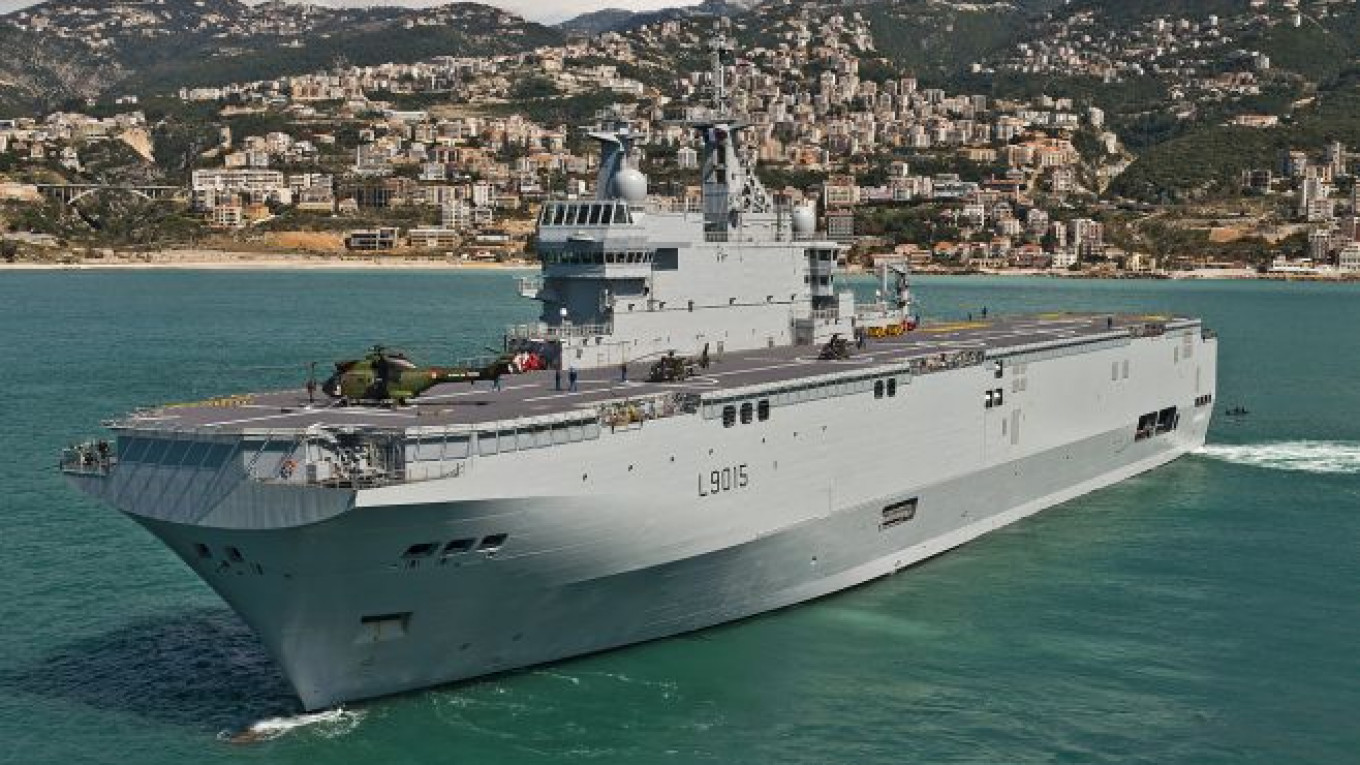With the first of two French-built Mistral class amphibious assault carriers set to be delivered to the Russian Navy in October, France is handing Russia the keys to one of the world's most advanced warships at a time when many in the West are questioning Moscow's expansionist ambitions.
In the wake of Russia's annexation of Crimea in March, the U.S. and several of its NATO allies have lobbied to convince the French government to withhold the ships, but Paris has held firm in its commitment to the deal.
The problem, in NATO's eyes, is not that France is selling Russia capable warships, but more that it is selling know-how: The ships have been assembled with the help of Russian engineers, who are learning the ins-and-outs of modern shipbuilding.
"The biggest concern for NATO is the foreign technology aspect, that is really the key," Dmitry Gorenburg, a senior researcher at Harvard and expert on Russian military modernization at CNA, a U.S.-based naval think tank, told The Moscow Times. "I would not dismiss the possibility that one of the ships would be put in the Black Sea and potentially used against a NATO member at some point down the road. It is a secondary concern, but it is there," he added.
Though it is unclear whether Russia will deploy one of the Mistral carriers to the Black Sea, the country's strategic interests in the region make it a distinct possibility. The naval base at the Crimean port city of Sevastopol is Russia's only warm-water port, and is key to Moscow's aim of reestablishing a presence in the Mediterranean Sea, which fizzled out after the Soviet Union collapsed.
Regardless of where the vessels go, the Mistral carriers give the Russian Navy versatility that it does not have and cannot domestically produce. With two Mistral carriers in its arsenal, the Navy would be able to drop a battalion of marines and armor on any coastline within 10,000 kilometers of its home port without refueling, provide helicopter support for those forces, and orchestrate an entire operation from the ship's advanced control center.
Were such an operation to fail spectacularly, Mistral can also serve as a hospital ship.
"Not even the Soviet Navy had such capabilities," said Mikhail Barabanov, a naval analyst at the Center for Analysis of Strategies and Technologies, a private Moscow-based defense think tank.
The Mistral Deal
The building of four Mistral class ships for the Russian Navy was commissioned in 2011 as part of a $1.7 billion technology-transfer agreement between Moscow and Paris. Under this agreement, the first two ships — the Sevastopol and the Vladivostok — were to be built by the French shipbuilding firm STX at Saint-Nazaire with Russian engineers on site to learn the techniques of modern shipbuilding.
The Sevastopol has been completed, and is due to be commissioned by the Russian Navy on Nov. 1. The Vladivostok will not be completed until later this year, and is expected to join the fleet in 2015.
Russia then has the option of producing the second two Mistral carriers at home, but no decision has been made Gorenburg said — the Defense Ministry and the Navy have different positions, and pressure from the Russian defense industry to focus on domestic designs might sink the idea.
Barabanov said Russia is unlikely to build the third and fourth carriers for both military and political reasons. The Baltic Shipyard in St. Petersburg has the best facilities in Russia for building large vessels like Mistral carriers, but its hands are currently full, having been tasked with the construction of large civilian icebreakers.
Rearmament
In the past several years, Russia has been rearming and modernizing its Navy as part of a $700 billion revamp of its armed forces through 2020, phasing out older submarine designs and replenishing the Navy's smaller corvette and frigate class vessels in an effort to bolster its coastal defense capabilities in the short term.
In the long term, the Russian Navy has its eye on regaining its permanent footing in the Mediterranean Sea, Barabanov said. "The ambitions of Russian naval modernization are to expand to a 'blue water navy' by actively building nuclear powered submarines and frigates, ordering the Mistral class expeditionary ships, and [potentially building] an aircraft carrier and a large destroyer."
Gorenburg said that while the construction of a new destroyer class was being discussed, any plans are far from being finalized. It is unlikely that Russia will construct anything bigger than a frigate before 2020, he said.
To that end, it will need larger, more advanced ships like cruisers and carriers, but this endeavor lives and dies by the defense budget and the Russian defense industry's ability to build such ships — a skill that it could pick up from Mistral.
Mistral's Military Value
Mistral is much more advanced than anything the Russian shipbuilding industry can currently produce. The ship not only doubles as an amphibious assault vessel and helicopter carrier — allowing Mistral to conduct land invasions and anti-submarine actions — but also boasts considerable capability as a command and control vessel and floating hospital.
The French Mistral design's sheer versatility makes it difficult to anticipate exactly what Russia will do with it, but analysts agree that it will most likely be used as a command ship. And if Russia is able to transfer some of its new technical expertise to the other boats of the fleet, the Mistrals will be heading more potent battle groups than the Soviets ever fielded.
One sticking point remains, however. To fully utilize Mistral's command and control capabilities, the Navy it requires modern communications technologies that Russia does not have, and it is not clear whether their transfer was part of the Mistral deal.
"The more modern stuff they get, the better for them. But, its still a little bit unclear what they are getting and what they are not getting," Gorenburg said.
The Black Sea Fleet
Aside from Russia's new access to technology, the future of the Black Sea Fleet also weighs heavy on Western minds, with the annexation of Crimea sparking fears that Moscow has designs on retaking its lost empire.
The perception that Moscow's Crimean maneuver was at least partly motivated by security concerns about the Black Sea Fleet has led some western analysts to conclude that the Russian Navy will station at least one of the vessels in Sevastopol.
Before the overthrow of Ukrainian President Viktor Yanukovych and his pro-Moscow regime in February, Russia felt that its naval influence has been significantly hindered by Kiev.
The 1997 agreement that allowed the Russia Navy to operate from Sevastopol, also limited the Black Sea Fleet to 30 vessels, and Kiev's consent was required before new ships could be transferred to the base. Many of the fleet's ships were considered modern nearly three decades ago, and are now well past their prime. Kiev's restrictions made it all the more difficult to modernize the fleet.
Now, with Crimea under Russian control, the threat to Russia's strategic presence in the Black Sea has subsided.
Barabanov said the Black Sea is crucial for Moscow because of "major areas of conflict" that exist for Russia in Crimea, Ukraine and Georgia. "Moreover, the Black Sea may be a convenient springboard for Western intervention in these areas, which must be prevented by the Black Sea Fleet," he said.
Sevastopol is also the best location to expand its naval presence into the Mediterranean Sea via the Bosphorus, the narrow waterway between the Black and Mediterranean Seas, which has been controlled by Turkey since 1936.
"The U.S.S.R. had a constant presence of ships in the Mediterranean, especially in the eastern Mediterranean. Sevastopol is the closest major port to that area. Now, it appears that there is some emphasis on rebuilding that presence," Gorenburg said.
Although the Soviet Union's leadership understood that Turkey, a member of the NATO alliance, would close the Bosporus in the event that war with NATO member states broke out, ships are free to come and go as they please during peacetime. As such, the primary goal of the Black Sea Fleet was to secure access to shipping lanes, the Suez Canal, as well as North African and Middle Eastern locations.
Comments from the head of the Black Sea Fleet seemed to add credibility to assertions that one of the ships will eventually end up in the Black Sea, but may also be bluster aimed at provoking the West.
"A major development program for the Black Sea Fleet is being planned. … Evidently, a Mistral-class assault ship will be among them," Admiral Alexander Vitko was quoted as saying by Interfax in mid-May.
Vitko's statement was later denied by a Navy spokesman, who said that both Mistral carriers would go to the Pacific. Sevastopol does not have the infrastructure to support the ships, but Vladivostok does, the spokesman said.
Considering the current political tensions between Russia and the West, there is a possibility that Moscow is simply biding its time before announcing that one of the carriers will go to the Black Sea to avoid giving NATO a reason to try to block the deal.
But Barabanov said it makes little sense to deploy a Mistral carrier to the Black Sea.
"The Mistral class ships are just not really needed for the Black Sea Fleet. The ship is designed for long-range expeditionary operations. In the Black Sea, all of Russia's objectives can be achieved [by the forces stationed] in Abkhazia and Crimea. The only purpose for deploying a Mistral class ship to the Black Sea would be as a command ship for Mediterranean operations," Barabanov said by e-mail.
Even if Ukraine and Europe do not wake up with a Mistral assault ship stationed by a resurgent Russia their backyard, the Russian Navy will soon be a more modern, more formidable force on the high seas.
A Message from The Moscow Times:
Dear readers,
We are facing unprecedented challenges. Russia's Prosecutor General's Office has designated The Moscow Times as an "undesirable" organization, criminalizing our work and putting our staff at risk of prosecution. This follows our earlier unjust labeling as a "foreign agent."
These actions are direct attempts to silence independent journalism in Russia. The authorities claim our work "discredits the decisions of the Russian leadership." We see things differently: we strive to provide accurate, unbiased reporting on Russia.
We, the journalists of The Moscow Times, refuse to be silenced. But to continue our work, we need your help.
Your support, no matter how small, makes a world of difference. If you can, please support us monthly starting from just $2. It's quick to set up, and every contribution makes a significant impact.
By supporting The Moscow Times, you're defending open, independent journalism in the face of repression. Thank you for standing with us.
Remind me later.






